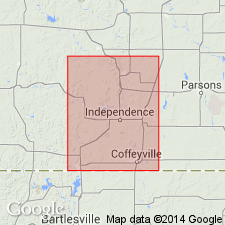
- Usage in publication:
-
- Buxton formation
- Modifications:
-
- Original reference
- Dominant lithology:
-
- Shale
- Sandstone
- Coal
- Limestone
- AAPG geologic province:
-
- Cherokee basin
Summary:
Pg. 447. Buxton formation. Shales, with beds of sandstone and coal and lenses of limestone; 320 feet thick. Underlies Painterhood [Oread] limestone and overlies Piqua [Stanton] limestone. Age is Pennsylvanian.
Named from Buxton, Wilson Co., southeastern KS.
Source: US geologic names lexicon (USGS Bull. 896, p. 306).

- Usage in publication:
-
- Buxton formation†
- Modifications:
-
- Abandoned
- AAPG geologic province:
-
- Cherokee basin
Summary:
Pg. 139. †Buxton formation includes beds from top of †Piqua (Stanton) limestone to base of †Painterhood (Oread) limestone.
Source: US geologic names lexicon (USGS Bull. 896, p. 306); GNC KS-NE Pennsylvanian Corr. Chart, sheet 2, Oct. 1936.
For more information, please contact Nancy Stamm, Geologic Names Committee Secretary.
Asterisk (*) indicates published by U.S. Geological Survey authors.
"No current usage" (†) implies that a name has been abandoned or has fallen into disuse. Former usage and, if known, replacement name given in parentheses ( ).
Slash (/) indicates name conflicts with nomenclatural guidelines (CSN, 1933; ACSN, 1961, 1970; NACSN, 1983, 2005, 2021). May be explained within brackets ([ ]).

